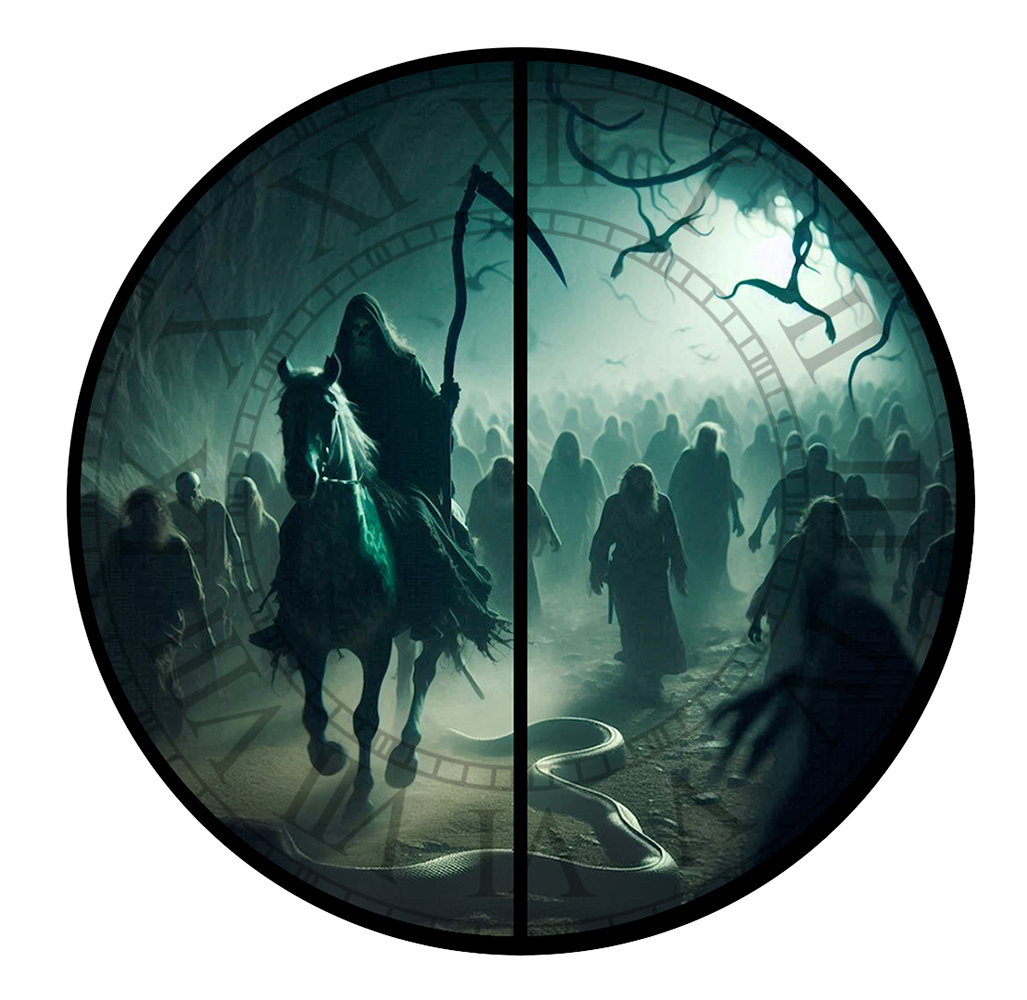 Revelation 6:8
Revelation 6:8

|
Strongs 2532
[list] Λογεῖον Perseus Kai Καὶ And Conj |
|
Strongs 3708
[list] Λογεῖον Perseus eidon εἶδον I/they perceived V-AIA-1S |
|
Strongs 2532
[list] Λογεῖον Perseus kai καὶ and Conj |
|
Strongs 2400
[list] Λογεῖον Perseus idou ἰδοὺ behold V-AMA-2S |
|
Strongs 2462
[list] Λογεῖον Perseus hippos ἵππος a horse N-NMS |
|
Strongs 5515
[list] Λογεῖον Perseus chlōros χλωρός pale Adj-NMS |
|
Strongs 2532
[list] Λογεῖον Perseus kai καὶ and Conj |
|
Strongs 3588
[list] Λογεῖον Perseus ho ὁ the Art-NMS |
|
Strongs 2521
[list] Λογεῖον Perseus kathēmenos καθήμενος he who is sitting V-PPM/P-NMS |
|
Strongs 1883
[list] Λογεῖον Perseus epanō ἐπάνω above Prep |
|
Strongs 846
[list] Λογεῖον Perseus autou αὐτοῦ himself PPro-GM3S |
|
Strongs 3686
[list] Λογεῖον Perseus onoma ὄνομα name N-NNS |
|
Strongs 846
[list] Λογεῖον Perseus autō αὐτῷ self/itself/himself PPro-DM/N3S |
|
Strongs 3588
[list] Λογεῖον Perseus HO Ὁ the Art-NMS |
|
Strongs 2288
[list] Λογεῖον Perseus Thanatos Θάνατος Death N-NMS |
|
Strongs 2532
[list] Λογεῖον Perseus kai καὶ and Conj |
|
Strongs 3588
[list] Λογεῖον Perseus ho ὁ the Art-NMS |
|
Strongs 86
[list] Λογεῖον Perseus hadēs ᾅδης Hades N-NMS |
|
Strongs 190
[list] Λογεῖον Perseus ēkolouthei ἠκολούθει he was accompanying V-IIA-3S |
|
Strongs 3326
[list] Λογεῖον Perseus met’ μετ’ in company with Prep |
|
Strongs 846
[list] Λογεῖον Perseus autou αὐτοῦ himself PPro-GM3S |
|
Strongs 2532
[list] Λογεῖον Perseus kai καὶ and Conj |
|
Strongs 1325
[list] Λογεῖον Perseus edothē ἐδόθη was given V-AIP-3S |
|
Strongs 846
[list] Λογεῖον Perseus autois αὐτοῖς to themselves PPro-DM3P |
|
Strongs 1849
[list] Λογεῖον Perseus exousia ἐξουσία right N-NFS |
|
Strongs 1909
[list] Λογεῖον Perseus epi ἐπὶ upon Prep |
|
Strongs 3588
[list] Λογεῖον Perseus to τὸ the Art-ANS |
|
Strongs 5067
[list] Λογεῖον Perseus tetarton τέταρτον fourth Adj-ANS |
|
Strongs 3588
[list] Λογεῖον Perseus tēs τῆς the Art-GFS |
|
Strongs 1093
[list] Λογεῖον Perseus gēs γῆς earth N-GFS |
|
Strongs 615
[list] Λογεῖον Perseus apokteinai ἀποκτεῖναι to kill away V-ANA |
|
Strongs 1722
[list] Λογεῖον Perseus en ἐν within Prep |
|
Strongs 4501
[list] Λογεῖον Perseus rhomphaia ῥομφαίᾳ sword N-DFS |
|
Strongs 2532
[list] Λογεῖον Perseus kai καὶ and Conj |
|
Strongs 1722
[list] Λογεῖον Perseus en ἐν within Prep |
|
Strongs 3042
[list] Λογεῖον Perseus limō λιμῷ famine N-DMS |
|
Strongs 2532
[list] Λογεῖον Perseus kai καὶ and Conj |
|
Strongs 1722
[list] Λογεῖον Perseus en ἐν within Prep |
|
Strongs 2288
[list] Λογεῖον Perseus thanatō θανάτῳ death N-DMS |
|
Strongs 2532
[list] Λογεῖον Perseus kai καὶ and Conj |
|
Strongs 5259
[list] Λογεῖον Perseus hypo ὑπὸ under Prep |
|
Strongs 3588
[list] Λογεῖον Perseus tōn τῶν the Art-GNP |
|
Strongs 2342
[list] Λογεῖον Perseus thēriōn θηρίων wild animals N-GNP |
|
Strongs 3588
[list] Λογεῖον Perseus tēs τῆς the Art-GFS |
|
Strongs 1093
[list] Λογεῖον Perseus gēs γῆς earth N-GFS |

Artificial Grass = "Worse than Pagans"
tender-shoot-colored = illegitimate sons/false brothers/not real
"And He Is mighty ones is saying toward the Serpent, "Because you have made this one, your eternal self is accursed more than every Wild Animal, and more than every animal of the Field...[i.e. domesticated]"
(Genesis 3:14 RBT)
"...his height, six mothers ("cubits") and a hand-span..."
"...inner body-armor of fish-scales...weighed 5000 shekel-weights of bronze..."
(1 Samuel 17:4-5 RBT)
"And Beloved ran [D1], and also he stood firm [D2], and he is taking the self-eternal sword of himself, and drawing her out of the sheath of herself and he is killing himself, and he is cutting down within her the self-eternal head of himself........"
(1 Samuel 17:51 RBT)And I saw, and behold a pale horse: and he sitting above him the name to him Death, and Hades follows with him. And power was given to them to kill upon the fourth of the earth, with sword, and by famine, and by death, and by wild beasts of the earth.
And I saw, and behold, a pale green horse, and the name of the one sitting on it was Death; and Hades followed after him. And authority was given to them to kill over the fourth of the earth with sword, and with famine, and with death, and by the wild beasts of the earth.
And I looked, and behold, a pale horse! And its rider’s name was Death, and Hades followed him. And they were given authority over a fourth of the earth, to kill with sword and with famine and with pestilence and by wild beasts of the earth.
Footnotes
| 9b | ἕστηκα is the first person singular perfect active indicative of the verb ἵστημι (histēmi), meaning "I cause to stand" or "I stand." The perfect tense in Greek indicates a completed action with a continuing state, which in English can be tricky to translate since there is often no sharp distinction between the present indicative and the perfect indicative when expressing a state. Thus, ἕστηκα literally means: "I have stood" (focusing on the completed action with present effect), |